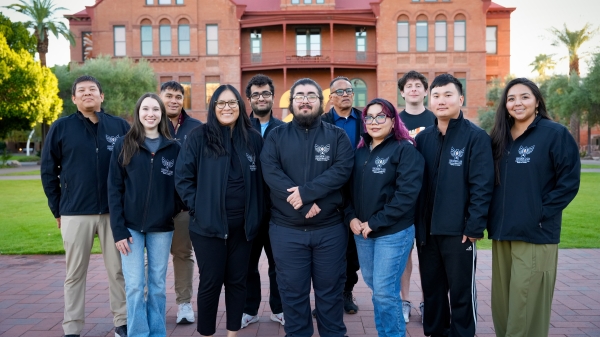The United States is facing complex cyber threats to its national security.
On Tuesday, the Biden administration unveiled a new National Cyber Workforce and Education Strategy. The first-of-its-kind approach plans to make U.S. security an imperative by solving the nation’s immediate and long-term cyber workplace needs, and preparing the country to lead the digital economy.
Prioritizing cyber workforce and education strategies is nothing new to Arizona State University. The Center for Cybersecurity and Trusted Foundations is already active in the cybersecurity workforce and education space, through internships, industry research collaborations and support for various competitive hacking teams.
In addition, ASU's School of Computing and Augmented Intelligence curriculum has been adopted by higher education organizations around the world, including California Polytechnic State University, The Ohio State University and University College London.
Cybersecurity expert Yan Shoshitaishvili, director of ASU’s Center for Cybersecurity and Trusted Foundations, provides some insight into the new government strategy and ASU’s efforts in this area.
Editor's note: Answers have been edited for length and clarity.
Question: What do you think about the approaches outlined in the White House strategy?
Answer: It's awesome to see a coherent national strategy in this space. The cybersecurity "skill gap" is something I talk about often, and as an educator, trying to bridge it can feel like a daunting task.
The straightforward approach (of the Biden strategy), coupled with the impressive array of committed organizations, seems like a good building block in providing a framework under which we can move the needle in cybersecurity workforce availability.
Q: Why is this a priority at this time in history?
A: A decade ago, nearly everything had a computer chip in it. Today, nearly everything has a computer chip in it that talks to the internet. This includes your door locks, financial systems, cars, power plants, hospital beds and basically everything that drives our lives. Increasingly, adversaries are catching up and chaos reigns in cyberspace.
Part of the reason is that there aren't enough people that can work to keep this chaos at bay, so of course it's a priority to train more of them.
Q: ASU already has cyber workforce and education strategies with a clear academic path to cybersecurity expertise. The School of Computing and Augmented Intelligence curriculum has even been adopted by higher education organizations globally, including Cal Poly, Ohio State University and University College in London. How long has this been a priority for ASU and why?
A: In some sense, this has been baked into ASU's mission ever since ASU's charter was adopted (in 2014). More specifically, ASU's pwn.college has been under development since 2018 and had a full global launch in 2020.
The platform is an innovative cybersecurity learning environment created to power much of our security curriculum and is in use at close to a dozen universities around the world. We created pwn.college because of a passion for practical cybersecurity education that, in turn, we developed through observing and participating in cybersecurity competitions.
Q: What makes ASU's efforts in this area unique?
A: Two things set our cybersecurity efforts apart: our practical focus and our open availability. The former sets us apart compared to many other cybersecurity programs.
In addition to learning about security policy and past security issues, our curriculum teaches students the actual technical subtleties behind security failures.
Going through our curriculum, students learn about security compromise and recovery at a deep enough level to reproduce examples of both, and using novel education techniques, we guide students on their learning journey through careful, gradual steps.
Of course, this is paired with the open online platform through which students around the world can — and more than 10,000 have — use pwn.college to bootstrap their cybersecurity knowledge.
I don’t think any other academic institution operates in this space as effectively and openly as we do — not Stanford, Carnegie Mellon, MIT or any of the usual suspects. For accessible, hands-on cybersecurity education, ASU is the best game in town.
Photo courtesy iStock/Getty Images
More Science and technology

Indigenous geneticists build unprecedented research community at ASU
When Krystal Tsosie (Diné) was an undergraduate at Arizona State University, there were no Indigenous faculty she could look to in any science department. In 2022, after getting her PhD in genomics…

Pioneering professor of cultural evolution pens essays for leading academic journals
When Robert Boyd wrote his 1985 book “Culture and the Evolutionary Process,” cultural evolution was not considered a true scientific topic. But over the past half-century, human culture and cultural…

Lucy's lasting legacy: Donald Johanson reflects on the discovery of a lifetime
Fifty years ago, in the dusty hills of Hadar, Ethiopia, a young paleoanthropologist, Donald Johanson, discovered what would become one of the most famous fossil skeletons of our lifetime — the 3.2…
